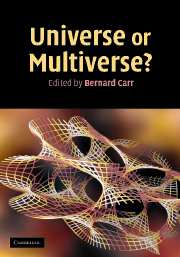Book contents
- Frontmatter
- Contents
- List of contributors
- Preface
- Acknowledgements
- Editorial note
- Part I Overviews
- Part II Cosmology and astrophysics
- 4 Cosmology and the multiverse
- 5 The anthropic principle revisited
- 6 Cosmology from the top down
- 7 The multiverse hierarchy
- 8 The inflationary multiverse
- 9 A model of anthropic reasoning: the dark to ordinary matter ratio
- 10 Anthropic predictions: the case of the cosmological constant
- 11 The definition and classification of universes
- 12 M/string theory and anthropic reasoning
- 13 The anthropic principle, dark energy and the LHC
- Part III Particle physics and quantum theory
- Part IV More general philosophical issues
- Index
- References
13 - The anthropic principle, dark energy and the LHC
Published online by Cambridge University Press: 05 July 2014
- Frontmatter
- Contents
- List of contributors
- Preface
- Acknowledgements
- Editorial note
- Part I Overviews
- Part II Cosmology and astrophysics
- 4 Cosmology and the multiverse
- 5 The anthropic principle revisited
- 6 Cosmology from the top down
- 7 The multiverse hierarchy
- 8 The inflationary multiverse
- 9 A model of anthropic reasoning: the dark to ordinary matter ratio
- 10 Anthropic predictions: the case of the cosmological constant
- 11 The definition and classification of universes
- 12 M/string theory and anthropic reasoning
- 13 The anthropic principle, dark energy and the LHC
- Part III Particle physics and quantum theory
- Part IV More general philosophical issues
- Index
- References
Summary
Naturalness versus the anthropic principle
The cosmological constant problem (CCP) is one of the most pressing problems in physics. It has eluded traditional approaches based on symmetries or dynamics. In contrast, the anthropic principle has scored a significant success in accounting for both the smallness of the cosmological constant (CC) and the proximity of the vacuum and matter energies in our universe [1]. Once we accept the anthropic principle as a legitimate approach for solving the CCP, it is natural to ask whether it might be applicable to other problems that can also be addressed with traditional methods. In this case, nature would have the interesting dilemma of choosing between an anthropic and a normal solution. An example is the gauge hierarchy problem (GHP). Like the CCP, it is a naturalness problem characterized by a small dimensionless number. Unlike the CCP, it can be solved with traditional symmetries, such as low-energy supersymmetry. As we will argue later, the GHP can also be addressed via anthropic arguments. So does nature choose the supersymmetric or the anthropic solution to the GHP? This question is far from academic, since the answer will be revealed experimentally by 2007 at the Large Hadron Collider (LHC).
The rise of naturalness as a principle for physics in the late 1970s led to the apparent need for a natural solution to the GHP and has convinced the majority of particle physicists that the LHC will discover either supersymmetry or another ‘natural’ theory that solves GHP. So if the LHC discovers nothing beyond the Standard Model, it will be a surprise. In our opinion, such a (non-)discovery would significantly strengthen the case for the anthropic principle and would cause a shift away from the usual naturalness-driven paradigm of attempting to understand the parameters of the Standard Model via symmetries or string theory. Instead, the nature of the dynamics that leads to the multiverse, and consequently provides a home for the anthropic principle, will become a primary question of physics. We now turn to this question.
Information
- Type
- Chapter
- Information
- Universe or Multiverse? , pp. 211 - 218Publisher: Cambridge University PressPrint publication year: 2007
